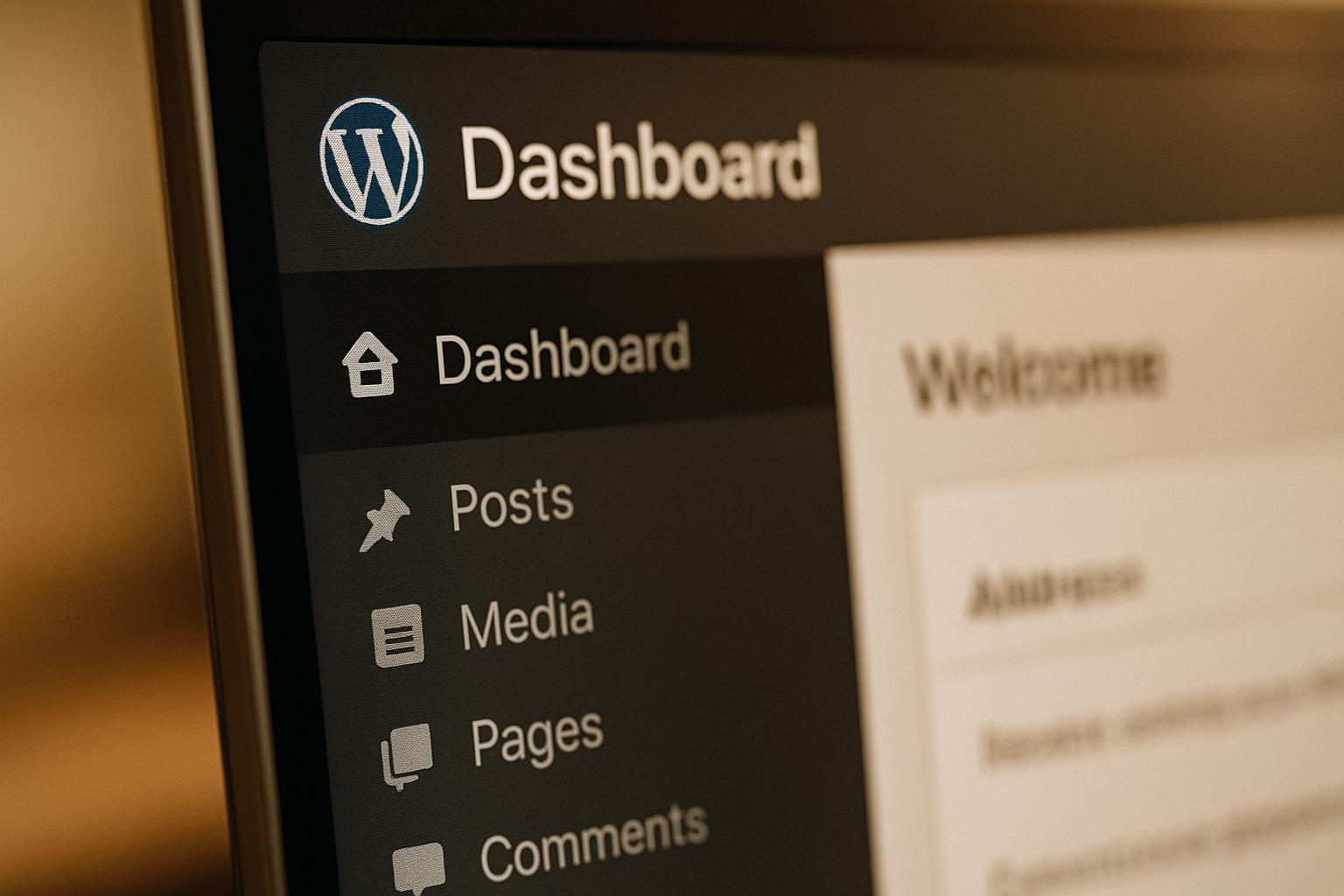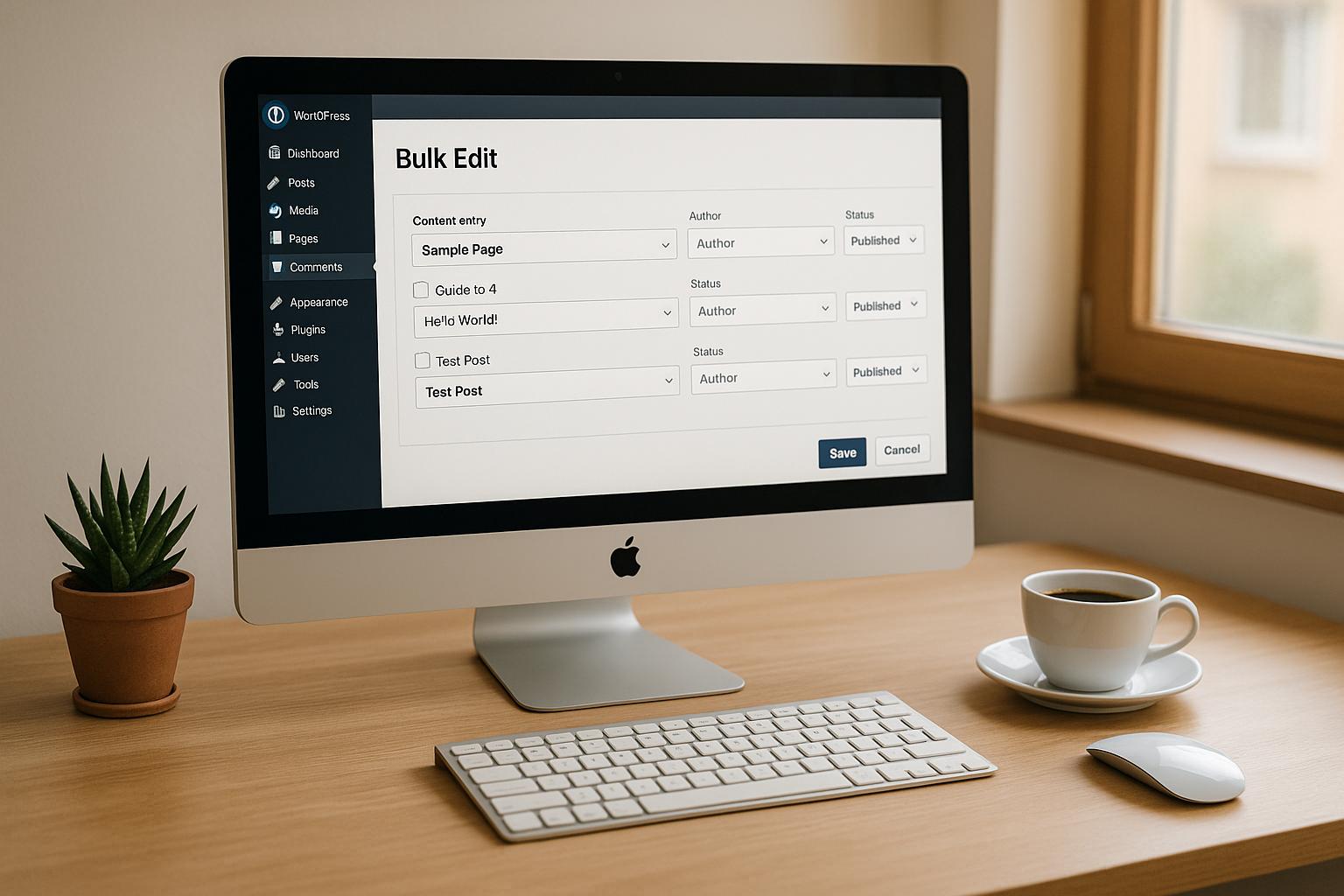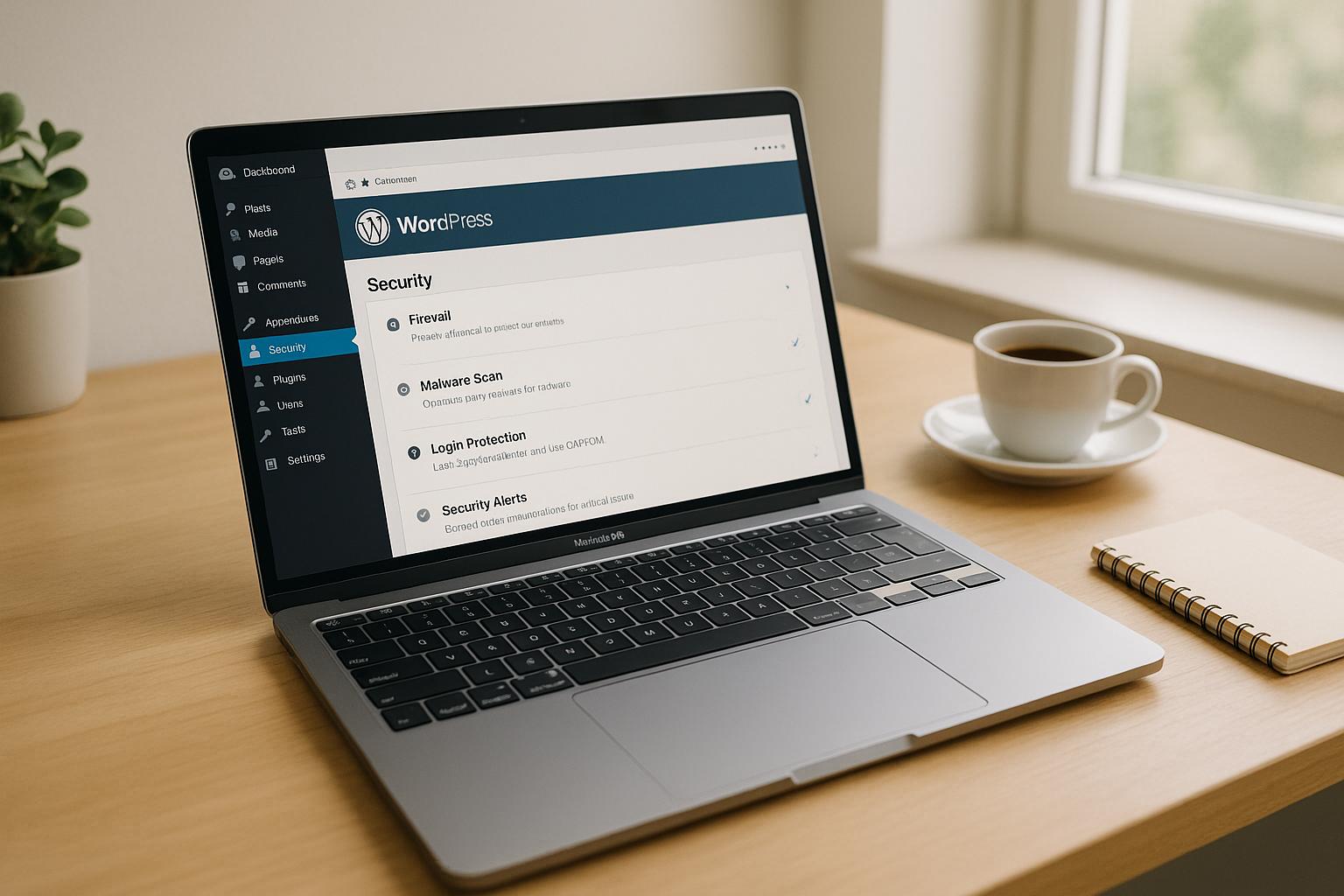Enterprise WordPress hosting demands strong security to protect sensitive data, ensure uptime, and meet compliance standards. Here’s a quick rundown of the 7 key security features every enterprise site should have:
- Firewalls: Act as the first line of defense, blocking malicious traffic and preventing attacks like SQL injection and XSS.
- DDoS Protection: Shields your site from traffic overloads that can cause downtime and revenue loss.
- Malware Scanning and Removal: Detects and removes harmful software in real time, safeguarding files and databases.
- SSL Certificates: Encrypts data between users and your site, protects sensitive information, and ensures compliance with regulations like PCI DSS.
- Automated Updates: Keeps WordPress core, plugins, and themes secure by applying patches immediately.
- User Authentication: Multi-factor authentication, role-based access, and IP restrictions protect admin areas from unauthorized use.
- 24/7 Monitoring: Continuous tracking of threats and quick incident response ensures your site stays protected at all times.
These features work together to create a layered security approach, minimizing risks while keeping your site operational and compliant. If you’re managing sensitive customer data or financial transactions, these tools aren’t optional – they’re essential.
WordPress Security in 2025: How to Scale Maintenance & Protect Enterprise Websites
1. Firewalls
Firewalls act as the first layer of defense for enterprise WordPress sites, monitoring and managing network traffic. These systems evaluate every request before it reaches your server, blocking harmful attempts while allowing legitimate users to access your site without interruption.
Enterprise-grade firewalls rely on rule-based filtering to make split-second decisions. They assess factors like IP addresses, request patterns, and traffic origins to identify and block malicious activity. This quick analysis ensures your site remains secure without slowing down legitimate traffic, creating a solid foundation for advanced threat protection.
Threat Prevention and Mitigation
Firewalls designed for enterprise WordPress sites are experts at intercepting threats before they can impact your site. Web Application Firewalls (WAFs) specifically tailored for WordPress are particularly effective against attacks such as SQL injection, cross-site scripting (XSS), and brute-force attempts.
These WordPress-specific WAFs are built with an understanding of the platform’s vulnerabilities. They can differentiate between acceptable and suspicious database queries, recognize normal user behavior, and identify unsafe file uploads.
Another layer of protection comes from geographic filtering. If your business primarily serves U.S.-based customers, you can block traffic from regions known for cybercrime. This significantly reduces your site’s exposure to potential attacks by cutting off access from high-risk areas.
Real-time Detection and Response
Modern firewalls go beyond static rules, adapting continuously through real-time updates. Machine learning plays a key role here, refining detection methods by analyzing typical traffic patterns. When unusual activity is detected, the system can immediately block it while your security team investigates.
Rate limiting is another essential feature, preventing a single IP address from overwhelming your server with excessive requests. This not only thwarts automated attacks but also protects your site during unexpected traffic surges, ensuring stability during critical operations.
Advanced systems also rely on threat intelligence databases that are updated hourly. These databases provide the latest information on emerging attack methods and malicious IP addresses, keeping your firewall up-to-date without requiring manual intervention.
Seamless Integration with WordPress Hosting
Firewalls designed for WordPress are built to integrate effortlessly with your hosting environment. They require no complex setup from your team and activate as soon as your site goes live, with preconfigured rules fine-tuned for WordPress security.
User-friendly dashboards make it easy to monitor activity, tweak security settings, and whitelist trusted IP addresses – no need to dive into server configurations. Detailed logs provide insights into blocked threats and the reasons behind those actions, giving you a clearer picture of your site’s security status.
For businesses with specific needs, custom rules can be added to accommodate unique plugins or functionalities. Hosting providers can adjust firewall settings to ensure your operations run smoothly while maintaining top-tier protection for your WordPress site.
2. DDoS Protection
After setting up strong firewall defenses, the next layer of protection for your site is targeted DDoS protection. DDoS attacks are a major concern for enterprise WordPress sites because they flood servers with excessive traffic, causing disruptions. These attacks can result in website downtime, lost revenue, and damage to your brand’s reputation. To counter this, enterprise WordPress hosting providers include DDoS protection as part of their security measures.
DDoS protection works by analyzing incoming traffic to differentiate between genuine user requests and suspicious activity. Tools like rate limiting and traffic filtering block harmful requests while ensuring legitimate users can access the site without interruptions. These solutions are designed to integrate smoothly into your hosting setup, working alongside advanced firewalls to create a robust security system.
One of the key features of these protections is automated detection and response. This means that attacks are identified and addressed in real time, keeping your site running smoothly and maintaining customer confidence. This multi-layered strategy strengthens your site’s overall defense.
For instance, WP Support Specialists offers enterprise WordPress hosting solutions with built-in DDoS protection, ensuring your site stays secure and accessible, even during high-stakes situations.
3. Malware Scanning and Removal
In addition to firewalls and DDoS protection, malware scanning plays a critical role in safeguarding your website from hidden dangers. Malware can compromise data security, harm your reputation, and disrupt operations. That’s why enterprise WordPress hosting providers offer robust malware scanning and removal systems.
Real-time Detection and Response
Effective malware scanning focuses on catching threats the moment they appear. Modern systems monitor your site around the clock, using signature-based detection to spot known threats and behavioral analysis to identify new, previously unseen malware. Once a threat is flagged, automated protocols kick in to isolate and remove it immediately.
These scans cover all site files, ensuring that even the most concealed threats – like backdoors, trojans, phishing scripts, or hidden cryptocurrency miners – are identified and dealt with swiftly.
Threat Prevention and Mitigation
Preventing malware is just as critical as detecting it. Real-time file integrity monitoring keeps an eye on your WordPress core files, sending alerts if any unexpected changes occur. Meanwhile, upload scanning checks all files before they’re stored on your server, stopping malicious content from ever reaching your live site.
To minimize risks, quarantine systems are used to isolate suspicious files without deleting them outright. This allows for manual review and recovery of any legitimate files that might have been flagged by mistake. By combining these prevention tools with real-time scanning, enterprise hosting providers create a comprehensive security strategy.
Seamless Integration with WordPress Hosting
Malware scanning tools are designed to integrate effortlessly with WordPress hosting. Automated scanning schedules are typically set to run during low-traffic periods, and the process is optimized to use minimal server resources.
Most enterprise solutions also include reporting dashboards that provide detailed insights into scan results, threat histories, and actionable recommendations. These reports empower administrators to assess their site’s security and make informed decisions about additional protective measures.
For example, WP Support Specialists includes malware monitoring and removal in their Secure Support & Maintenance plans. This ensures your WordPress site remains clean and secure, backed by professional oversight and rapid response when threats arise.
4. SSL Certificates and Data Encryption
SSL certificates and encryption are essential for safeguarding the connection between your WordPress site and its users. Enterprise WordPress hosting relies on these tools to secure sensitive information like login details, payment data, and personal information.
Threat Prevention and Mitigation
SSL certificates establish an encrypted link between a user’s browser and your server, effectively stopping data interception or tampering. This encryption uses AES-256 bit standards, a level of security trusted by banks and government agencies.
Modern enterprise hosting platforms also implement HTTP Strict Transport Security (HSTS) policies, which enforce HTTPS connections. Additionally, advanced protocols like Perfect Forward Secrecy (PFS) ensure that even if encryption keys are compromised, past communications remain secure.
Many enterprise hosting solutions go a step further by offering database encryption at rest, which protects critical WordPress assets such as files, media, plugins, and themes. These measures not only protect your data but also help your organization meet strict regulatory requirements.
Compliance with US Regulations
If your business operates in sectors like healthcare or e-commerce, compliance with standards such as HIPAA and PCI DSS is non-negotiable. Both require end-to-end encryption to protect user data.
State regulations, like the California Consumer Privacy Act (CCPA), mandate "reasonable security measures" to protect consumer information. SSL certificates play a vital role in meeting these standards, helping businesses avoid fines that can reach up to $7,500 per violation. Enterprise hosting providers often include Extended Validation (EV) SSL certificates, which provide the highest level of authentication. These certificates display a green address bar, instilling trust and demonstrating compliance.
Ease of Integration with WordPress Hosting
SSL integration with enterprise WordPress hosting isn’t just secure – it’s also user-friendly. Many platforms simplify SSL management through automation. For example, Let’s Encrypt integration offers free SSL certificates that renew automatically, eliminating the need for manual intervention. Hosting solutions often support wildcard SSL certificates, allowing you to secure your main domain and all subdomains with a single certificate.
Most enterprise platforms also include one-click SSL activation, which automatically configures WordPress settings and resolves mixed content issues.
WP Support Specialists provides comprehensive SSL management as part of their hosting and maintenance services. They handle certificate installation, renewal, and optimize WordPress configurations for security. Their thorough security audits include SSL implementation reviews to identify and fix vulnerabilities, ensuring your site remains protected. This level of SSL management is just one of the essential security features for enterprise WordPress hosting.
sbb-itb-976b402
5. Automated Updates and Patch Management
Keeping your WordPress site secure means staying on top of updates and patches for the core platform, themes, and plugins. These updates often include fixes for security vulnerabilities, and delaying them can leave your site open to attacks. Automated updates streamline this process, working alongside firewalls and malware scans to create a solid, layered defense system.
Threat Prevention and Mitigation
When security issues in WordPress components are discovered, they can quickly become a target for cybercriminals. Automated patch management eliminates the lag that often comes with manual updates, ensuring vulnerabilities are addressed as soon as possible. Many platforms test patches in a staging environment before rolling them out to live sites, reducing the risk of breaking functionality. They also rely on vulnerability databases to prioritize critical updates over less urgent ones. If an update causes problems, rollback features allow you to revert to a previous version, minimizing disruption.
Compliance with US Regulations
For businesses that handle sensitive data, timely updates aren’t just a good practice – they’re often a requirement. Standards like PCI DSS mandate the swift application of vendor-supplied security patches for companies processing payment information. Similarly, organizations governed by HIPAA must maintain current software as part of their broader security framework. Detailed logs of these updates also help meet audit and compliance requirements.
Seamless Integration with WordPress Hosting
Automated updates fit naturally into enterprise WordPress hosting setups. Hosting platforms typically offer features like smart scheduling and compatibility checks, ensuring updates happen smoothly. You can customize which components update automatically – security patches can run on autopilot, while feature updates remain under manual control. Staging environments test updates before deployment, and email notifications keep you informed of successes or any issues. Updates can even be scheduled to align with your business’s maintenance windows or time zones, balancing security with operational needs.
WP Support Specialists simplifies this entire process with their comprehensive update management services. They handle updates for WordPress core, themes, and plugins, complete with pre-update backups and compatibility testing. Their automated systems monitor for security patches and apply them promptly, all while maintaining detailed logs for audits. This hands-off approach ensures your WordPress site stays secure without requiring constant manual effort.
6. User Authentication and Access Controls
Adding to firewalls, DDoS protection, and malware scanning, strong user authentication is a key piece of your site’s security puzzle. It helps safeguard your admin areas by requiring more than just basic passwords to gain access.
Threat Prevention and Mitigation
Multi-factor authentication (MFA) is one of the best ways to defend against stolen or weak passwords. By requiring extra verification steps – like SMS codes, authenticator apps, or hardware tokens – MFA makes it much harder for brute force or credential stuffing attacks to succeed.
Role-based access control ensures users only have permissions they truly need. Instead of giving everyone admin access, you can assign roles like editor, author, or contributor. You can also create custom roles tailored to specific tasks, limiting access to only the features and content areas relevant to each team member’s responsibilities.
IP whitelisting and geolocation restrictions add another layer of protection. For example, you can block access from unknown locations or restrict admin logins to specific office IP addresses. Additionally, monitoring failed login attempts and locking out users after multiple unsuccessful tries stops automated tools from cycling through passwords.
These measures not only protect your site but also help meet strict U.S. data protection standards.
Compliance with US Regulations
Access controls are essential for following regulations when handling sensitive data.
- SOX compliance: Publicly traded companies must tightly control access to financial systems. WordPress sites handling financial data need strong user authentication and detailed access logs to meet these requirements.
- HIPAA regulations: Healthcare organizations must secure protected health information with unique user IDs, emergency access procedures, and automatic logoff features. Multi-factor authentication is a must for sites dealing with patient data or healthcare communications.
- PCI DSS standards: Businesses processing credit card transactions must assign unique IDs to users, restrict access based on need, and use multi-factor authentication for admin access to cardholder data.
Seamless Integration with WordPress Hosting
Enterprise WordPress hosting platforms simplify the process of implementing advanced authentication features, often without requiring technical expertise.
- Single Sign-On (SSO) allows employees to log in using their existing corporate credentials from systems like Active Directory or Google Workspace.
- API-based authentication ensures secure communication with third-party applications while centralizing control over access.
- Automated provisioning and deprovisioning make user management efficient. For instance, HR system integration can automatically set up new user accounts with the right permissions and disable accounts immediately when employees leave, reducing security risks.
These tools, along with other security features, strengthen your WordPress site’s defenses.
WP Support Specialists can further enhance your site’s security by conducting detailed access control audits and setting up customized authentication systems. Their team can configure multi-factor authentication, align role-based permissions with your business needs, and implement monitoring tools to track user activity across your WordPress environment.
7. 24/7 Security Monitoring and Incident Response
Keeping your WordPress environment secure around the clock is critical. Even when your team is offline, continuous monitoring ensures potential threats are spotted and addressed before they escalate. This approach combines smart automated tools with expert human oversight to safeguard your site effectively.
Real-time Detection and Response
With continuous threat monitoring, advanced algorithms analyze traffic, file changes, and user behavior across your WordPress setup. These tools can quickly identify suspicious activities, like unusual login attempts, unauthorized file edits, or abnormal database queries.
Automated incident responses act immediately to contain threats. For instance, if a brute force attack is detected, the system can block offending IP addresses, lock compromised accounts, and notify your security team without delay.
Security information and event management (SIEM) platforms take this a step further. By gathering and analyzing data from various sources – firewalls, server logs, and application monitors – they can identify complex attack patterns. For example, if multiple failed logins coincide with strange file access, the system flags it as a potential coordinated attack.
Threat Prevention and Mitigation
Beyond real-time responses, proactive measures help defend against new and evolving threats. Behavioral analysis learns what normal activity looks like and flags anomalies, such as sudden spikes in database queries or unexpected file uploads.
Security analysts play a key role by actively searching for hidden threats rather than relying entirely on automation. They dig into log files, network activity, and system behaviors to uncover advanced threats that might otherwise slip through unnoticed.
When breaches do occur, incident containment and recovery steps minimize damage. Automated systems can isolate infected servers, activate clean backups, and begin recovery processes. For example, if malware is found on your WordPress site, traffic can be redirected to a clean backup while the issue is resolved and infected files are quarantined.
Compliance with US Regulations
Strong security practices also support compliance with U.S. regulations, enhancing your overall defense strategy. Audit trail maintenance ensures all security events are logged and stored according to legal requirements. For businesses under SOX compliance, for instance, logs of administrative actions, system changes, and incidents must be kept for at least seven years.
Incident reporting requirements vary by industry. HIPAA requires reporting breaches involving protected health information within 60 days, while PCI DSS mandates immediate notification for payment card data breaches. Automated monitoring tools can generate reports that include all the necessary details, from incident timelines to affected systems and remediation steps.
Data retention and forensic capabilities are also vital. Detailed logs maintained by monitoring systems can aid in forensic investigations, showing how breaches occurred and demonstrating your organization’s diligence in following security protocols.
Ease of Integration with WordPress Hosting
To be effective, monitoring tools must work seamlessly with your WordPress setup without slowing it down. Smooth integration ensures these tools operate alongside your site’s core functions, addressing WordPress-specific threats like plugin vulnerabilities, theme exploits, and database injection attacks.
A centralized dashboard simplifies management, allowing administrators to monitor multiple WordPress sites, review security incidents, and manage responses all in one place. This is especially helpful for businesses or agencies overseeing several installations.
Automated escalation procedures ensure timely responses based on the severity of a threat. Minor issues might trigger email alerts and automated fixes, while critical threats could prompt immediate phone calls to your security team for urgent action.
WP Support Specialists can enhance your security setup by offering expert analysis and custom response plans. Their team can tailor monitoring systems to suit your business needs, set up appropriate alert thresholds, and create incident response playbooks specific to your WordPress environment and compliance requirements.
Security Features Comparison
When it comes to enterprise WordPress hosting, picking the right security features means understanding their strengths and limitations. Each layer of protection serves a specific purpose, so comparing their roles can help you create a tailored defense strategy.
Take hardware firewalls, for instance. These act as physical gatekeepers for your network, delivering high performance for sites with heavy traffic – especially those surpassing 10 Gbps. They come equipped with tools like SSL interception, intrusion prevention, deep packet inspection, web application firewalls, and VPN servers. However, they require a significant upfront investment, physical setup, and skilled personnel to manage and maintain them.
On the other hand, software firewalls operate at the server level, offering precise control over individual WordPress environments. They’re a great fit for cloud-based or containerized setups and are often bundled with operating systems or available through affordable subscriptions. The trade-off? Their performance depends on the host system’s resources, which could impact your site’s speed if resources are stretched thin.
Here’s a quick comparison of key security features:
| Security Feature | Best For | Primary Advantage | Main Limitation |
|---|---|---|---|
| Hardware Firewalls | High-traffic enterprise sites | High performance and centralized control | High initial costs and physical upkeep |
| Software Firewalls | Cloud-based WordPress hosting | Easy deployment and detailed control | Limited by host resources |
| DDoS Protection | Public-facing content sites | Filters attack traffic automatically | Risk of blocking legitimate traffic |
| Malware Scanning | Content-heavy WordPress sites | Detects threats proactively | Can slow down performance during scans |
| SSL Certificates | E-commerce and data collection | Encrypts data and builds trust | Needs proper setup and regular renewal |
Looking specifically at DDoS protection, cloud-based solutions can handle massive attack volumes but might introduce slight delays during normal operations. On-premise options, while quicker to respond, may struggle with large-scale attacks. Your choice should depend on your traffic patterns and tolerance for latency.
Authentication and access control measures are also critical, especially for WordPress sites managed by multiple users. However, these systems can sometimes frustrate users, so it’s crucial to strike a balance between robust security and ease of use.
For maximum security, consider combining hardware and software firewalls. This layered approach safeguards both the network’s perimeter and individual WordPress instances, offering redundancy. If one layer fails, the other can still protect your site.
Cost is another factor to weigh. While software firewalls may seem cheaper initially, ongoing subscriptions can add up over time, potentially surpassing the cost of hardware solutions. Additionally, managing software firewalls across numerous devices can be labor-intensive in large environments.
To make informed decisions, consult experts like WP Support Specialists, who can assess your current security setup and recommend solutions tailored to your traffic, compliance needs, and budget. A well-thought-out multi-layered strategy ensures your WordPress site stays secure without breaking the bank.
Conclusion
Securing an enterprise WordPress site means weaving together a variety of protective measures that complement one another. Each of the seven security features we’ve discussed plays a distinct role, and when combined, they form a strong shield against modern threats.
Enterprise WordPress security relies on layered defenses – tools like firewalls, real-time monitoring, and more – all working to address specific vulnerabilities. This approach is not just about keeping hackers at bay; it’s also about meeting U.S. compliance standards such as HIPAA, SOX, and PCI DSS. Falling short on these standards could result in severe financial penalties and damage to your reputation.
It’s important to remember that safeguarding your site isn’t just about protecting customer data. Your WordPress platform likely holds proprietary business information, employee records, financial data, and even strategic plans. All of this requires a thorough and well-thought-out security framework.
If you’re unsure how to implement these features or which ones are most critical for your setup, it’s worth seeking expert advice. WP Support Specialists can evaluate your existing security measures and recommend a tailored plan that fits your compliance needs, traffic demands, and budget.
In today’s digital world, enterprise WordPress security isn’t just a nice-to-have – it’s a must. Protecting your business, earning customer trust, and staying compliant with regulations all hinge on having the right strategy in place. Take action now to secure your WordPress environment by consulting with specialists who can guide you toward a customized solution.
FAQs
How do security features in enterprise WordPress hosting work together to protect your website?
Enterprise WordPress hosting takes a comprehensive approach to security, layering multiple defenses to keep your website safe. It combines features like firewalls, malware scanning, SSL encryption, and real-time monitoring to create a strong shield against potential threats.
Firewalls act as the first line of defense, stopping harmful traffic before it can even reach your site. Malware scanners work behind the scenes to detect and eliminate risks. With SSL encryption, all data exchanged on your site remains safe and private. Meanwhile, real-time monitoring keeps an eye out for vulnerabilities, addressing issues before they escalate. These tools work together seamlessly to build a scalable and reliable security system, keeping your site protected in an ever-changing digital landscape.
What compliance standards can enterprise WordPress hosting help your business meet?
Enterprise WordPress hosting with robust security measures can help businesses align with important standards like SOC 2 Type II, ISO 27001, PCI DSS, GDPR, and HIPAA. The ability to meet these standards often depends on the hosting provider’s certifications and security controls. Key elements include data encryption, regular updates, strict access controls, and independent third-party audits.
With features like firewalls, DDoS protection, malware scanning, and SSL encryption, enterprise hosting solutions provide the tools needed to protect sensitive information. These measures are especially crucial for industries such as healthcare, finance, and e-commerce, where regulatory compliance and data security are non-negotiable.
What steps can businesses take to secure their WordPress site while avoiding disruptions during updates and scans?
Keeping your WordPress site secure doesn’t have to be a headache. Start by testing updates in a staging environment before rolling them out to your live site. This way, you can catch any issues before they affect your visitors.
Turn on automatic updates for critical security patches to ensure your site remains protected without requiring constant manual intervention. Schedule updates during low-traffic hours to reduce the risk of disrupting your audience, and always test thoroughly before making changes live.
Don’t forget regular backups – they’re your safety net. If something goes wrong, you can quickly restore your site without losing valuable data. Pair these steps with consistent monitoring to keep your site secure and running smoothly.







